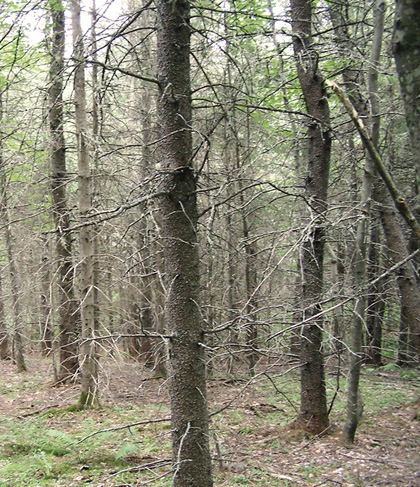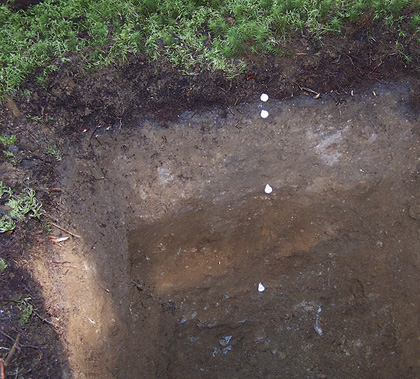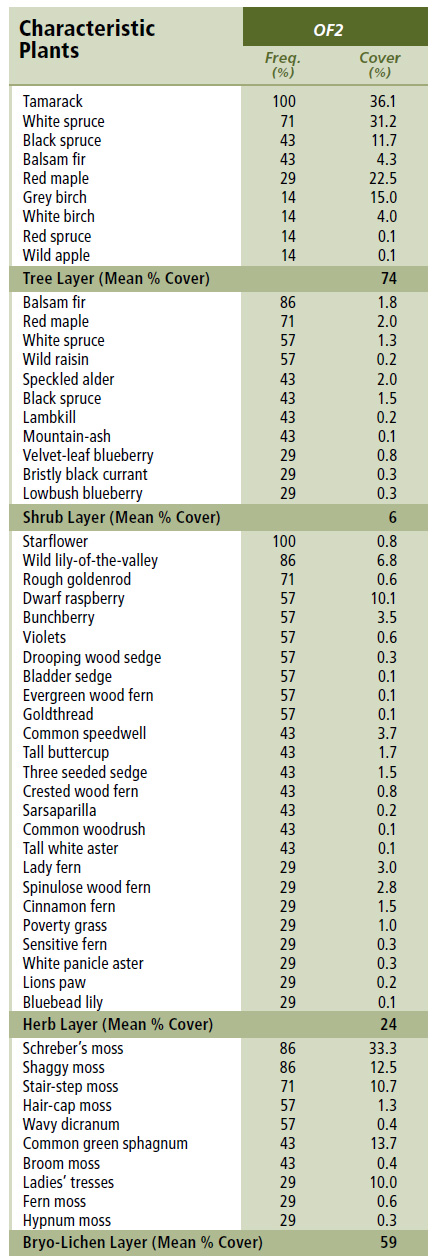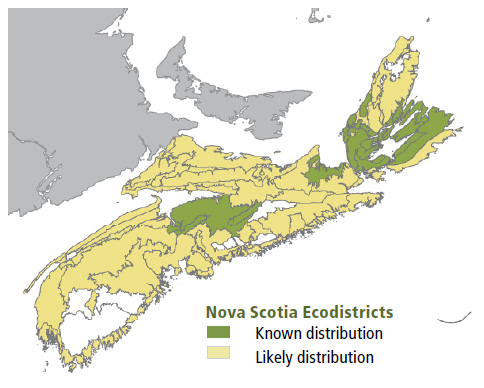
Forest Vegetation types - OF2
OF2 — Tamarack / Speckled alder / Rough goldenrod / Shaggy moss
Larix laricina / Alnus incana / Solidago rugosa / Rhytidiadelphus triquetrus
 |
Sugar Camp Brook Quarry, Inverness |
Concept: This early successional Vegetation Site (VT) has abundant tamarack and white spruce, often with a minor component of black spruce or balsam fir. This VT is similar to OF1 (White spruce / Aster – Goldenrod / Shaggy moss), but is usually found on moister sites. OF2 stands usually have fully developed canopies resulting in needle carpet and/or moss-dominated forest floors with reduced shrub and herb cover. OF2 is found throughout the province on imperfectly drained old field sites.
Vegetation: Tamarack and white spruce are the dominant overstory trees. Black spruce, Balsam fir and red maple are common associates. The poorly to moderately developed shrub layer consists mainly of regenerating trees along with wild raisin and speckled alder. The herb layer is better developed, with species like hawkweeds, goldenrods, asters, strawberry, common speedwell, tall buttercup, bedstraws and grasses; most of which reflect previous agricultural land-use. Cinnamon fern, interrupted fern, sedges and sensitive fern can also be found on sites with higher relative soil moisture. Moss cover can be variable and interspersed with needle carpet. Where present, moss species include Schreber's moss, shaggy moss and stair-step moss. Sphagnum species can also be found on wetter microsites
in the stand.
Environmental Setting: OF2 is mainly associated with moist to moist-wet, nutrient medium to rich soils of variable texture. This VT is scattered throughout Nova Scotia wherever imperfectly drained old field sites are found. Sites that have been tilled or pastured have level microtopography and a distinct Ap (plough layer) soil horizon.
Successional Dynamics: OF2 is an even-aged, early successional VT dominated by tamarack and white spruce. The short life span of these species, and their inability to re-establish themselves under their own canopy cover, are factors which eventually lead to the collapse of this ecosystem. Natural disturbance agents include insects (e.g. larch sawfly, larch casebearer, bark beetles, tussock moth, spruce budworm) and windthrow. Subsequent successional stages usually include species indicative of original pre-agricultural forest cover, especially if suitable seed sources are nearby. Stands that slowly deteriorate are more likely to succeed to such forest conditions as shade-tolerant species start to regenerate on site. Clearcut harvesting may trigger an earlier successional stage dominated by grey birch, pin cherry, aspen, white birch and/or other woody shrubs. Depending in part on the level of advanced regeneration present at time of harvest, OF2 may also succeed to OF4 (Balsam fir –White spruce / Evergreen wood fern – Wood aster), OF5 (Trembling aspen – Grey birch / Rough goldenrod – Strawberry) or other VTs dominated by white birch and/or red maple. Other possible successional stages include MW4 (Balsam fir – Red maple / Wood sorrel – Goldthread) and eventually MW1 (Red spruce – Yellow birch/ Evergreen wood fern).
Ecological Features: Past cultivation across this patch forest has leveled most pre-disturbance micro topography, while rock walls and piles, old foundations and wells provide additional evidence of agricultural land use. Linear rock piles may provide dwellings for rodents, snakes, and insects like wasps and bees. Other unique aspects include the forest's close proximity to open fields and active farms and the frequent presence of fruit trees. These features may attract deer, red fox, coyotes, red squirrels, small mammals, and several birds including ruffed grouse, thrushes, crows and blue jays. Alders provide habitat for woodcock. OF2 has excellent growing conditions for mycorrhizal mushrooms including chanterelle and hollow foot suillus, which are respectively allied with spruce and larch. Although these forests add to landscape structure, they have a simplified ecological make-up, reflected by low
tree diversity, structural complexity
and deadwood volume.
 |
| Plough Layer (Ap horizon) |
Distinguishing Features: This softwood forest on imperfectly drained soils is dominated by tamarack with white spruce. Level microtopography and a soil profile that shows a plough layer are good site indicators. Sphagnum moss is common in depressions.
| Slope Position: | Lower3 Middle3 Level3 Upper1 |
Surface Stoniness: |
(Non - Slightly)9 (Moderately)1 |
Bedrock Outcrop: |
(Non-rocky)10 |
Elevation Range: |
4 - 152m |
Slope Gradient: |
Gentle6 Level4 |
Aspect: |
North3 East4 West1 None2 |
Exposure: |
Moderate8 Mod. exposed1 Mod. Sheltered1 |
Microtopography: |
Slightly6 Level4 |
Drainage: |
Imperfect4 Moderately well3 Poor3 |
Soil Type: |
ST125 ST132 ST3-L1 ST71 ST91 |
Parent Material: |
Glacial till10 |
Rooting Depth (cm): |
(<30)44 (30-45)5 (>45)1 |
Duff Thickness (cm): |
(0-5)8 (6-10)1 (11-20)1 |

